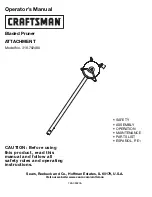
32
5 Operating Procedures
RIP FENCE OPERATION
• Unlock the fence by lifting the locking lever. Using the scale for placement, position the rip fence. Lock the
rip fence into position by placing the locking lever in the down position.
• The rip fence is used for the following operations: ripping, bevel ripping, ploughing, resawing, rabbeting and
dadoing.
WARNING: For your own safety, always observe the following safety precautions.
• Never make any cut freehand (without using miter gauge or rip fence). Blade can bind in the cut and cause
a kick-back.
• Always lock miter gauge or rip fence securely when in use.
• Remove rip fence from the table when miter gauge is in use.
• Remove miter gauge from table when rip fence is in use.
• Make sure blade guard is installed for all “through sawing” operations. Through sawing operations are
those operations in which the saw blade cuts completely through thethickness of the wood. Replace guard
immediately after completion of resawing, rabbeting and dadoing. Frequently check action of anti-kickback
pawls by passing the workpiece alongside the spreader while saw is off. Pull the workpiece toward you. If
the pawls do not dig into the workpiece and hold it, the pawls must be sharpened. (See Maintenance section)
• Have blade extend approximately 1/8″above top of workpiece. Additional blade exposure increases hazard
potential.
• Do not stand directly in front of blade in case of a kick-back. Stand to either side of the blade.
• Keep your hands clear of the blade and out of the path of the blade.
• If the blade stalls or stops while cutting, turn switch OFF and safety disconnect OFF before attempting to
free the blade.
• Do not reach over or behind the blade to pull the work-piece through the cut, to support long or heavy work-
pieces, to remove small cut-off pieces of material or for any other reason.
• Do not pick up small pieces of cut-off material from the table. Remove them by pushing them off table with
a long stick. Otherwise they could be thrown back at you by the rear of the blade.
• Do not remove small pieces of cut-off material that may become trapped inside blade guard while saw is
on. This could endanger your hands or cause a kickback. Turn saw off. After blade has stopped turning, lift
guard and remove the piece.
• Always lower blade below the table level when machine is not in use.
5.4 Types of Cuts/Operations
CROSSCUTTING
WARNING: Use caution when starting the cut to prevent binding of the guard against the workpiece.
This cut is performed with the miter gauge set at “0”, and is used for cutting across the workpiece grain at 90°
(blade square with both the edge and fl at side of wood).
MITER CUTTING
WARNING: Miter angles greater than 45° may force the blade guard assembly into the saw blade causing damage
Содержание SC.1100.X
Страница 11: ...11 2 Safety Regulations ...
Страница 40: ...40 8 Exploded View 8 Exploded View ...
Страница 43: ...43 8 Exploded View ...
Страница 45: ...45 8 Exploded View ...
Страница 48: ...48 8 Exploded View ...
Страница 50: ...50 9 Wiring Diagram WIRING DIAGRAM 3 Wire 220V 1Phase 9 Wiring Diagram ...
















































